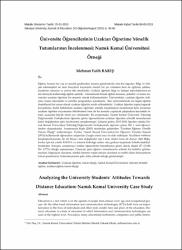| dc.contributor.author | Barış, Mehmet Fatih | |
| dc.date.accessioned | 2022-05-11T14:47:31Z | |
| dc.date.available | 2022-05-11T14:47:31Z | |
| dc.date.issued | 2015 | |
| dc.identifier.issn | 2146-7455 | |
| dc.identifier.issn | 2146-7455 | |
| dc.identifier.uri | https://app.trdizin.gov.tr/makale/TVRnME5UVXlNZz09 | |
| dc.identifier.uri | https://hdl.handle.net/20.500.11776/10509 | |
| dc.description.abstract | Eğitim, hemen her yaş ve meslek grubundan insanın gündeminde olan bir olgudur. Bilgi ve ileti- şim teknolojileri ise hem bireylerin hayatında önemli bir yer tutmakta hem de eğitimin şekline, modeline, süresine ve yerine etki etmektedir. Uzaktan öğretim, bilgi ve iletişim teknolojilerinin en üst düzeyde kullanıldığı eğitim şeklidir. Günümüzde birçok eğitim kurumu, şirketler ve kamu kurumları uzaktan öğretimi bir seçenek olarak kullanmaktadır. Üniversiteler, uzaktan öğretim önlisans, lisans, lisansüstü ve sertifika programları açmaktadır. Bazı üniversitelerde ise örgün eğitimi destekleyici bir unsur olarak uzaktan öğretim tercih edilmektedir. Uzaktan öğretim yapan/yapacak kurumların, hedef kitlelerinin uzaktan öğretime yönelik tutumlarının incelenmesi hem kurumun uzaktan öğretim vizyonunun belirlenmesi hem de bu konuda yapılacak çalışmalara kaynaklık etmesi açısından büyük önem arz etmektedir. Bu araştırmada, Namık Kemal Üniversite Tekirdağ Değirmenaltı Yerleşkesinde öğrenim gören öğrencilerinin uzaktan öğretime yönelik tutumlarının farklı değişkenlere göre incelenmesi amaçlanmıştır. Çalışma grubu, 2013-2014 öğretim yılında Namık Kemal Üniversitesi Tekirdağ Değirmenaltı Yerleşkesinde öğrenim gören 282 1. sınıf öğrencisinden oluşmaktadır. Araştırmada Kışla (2005) tarafından geliştirilen Uzaktan Eğitime Yönelik Tutum Ölçeği? kullanılmıştır. Veriler, Namık Kemal Üniversitesinin Öğrenim Yönetim Sistemi (ÖYS) kullanılarak öğrencilere ulaştırılan Google anket aracı ile elde edilmiştir. Niceliksel verilerin karşılaştırılmasında, iki alt düzeyi olan değişkenler için t-testi, ikiden fazla alt düzeyi olan değiş- kenler için tek yönlü ANOVA ve anlamlı farklılığa neden olan grubun tespitinde Scheffe testi kullanılmıştır. Sonuçta, araştırmaya katılan öğrencilerin tutumlarının genel olarak düşük ( ? 2,440; SS= 0,721) olduğu saptanmıştır. Cinsiyete göre öğrenci tutumlarında anlamlı bir farklılık gözlenmezken, bilgisayarı olanların, sürekli internet erişim imkanı olanların ve mobil cihazı bulunanların tutum puanlarının, bulunmayanlara göre daha yüksek olduğu gözlenmiştir. | en_US |
| dc.description.abstract | Education is a fact which is on the agenda of people from almost every age and occupational groups. On the other hand information and communication technologies (ICTs) both have an important place in the lives of individuals and effect style, model, time and place of the education. Distance education is a form of education in which information and communication technologies are used at the highest level. Nowadays, many educational institutions, companies and public institutions are using the distance education as an option. Universities are establishing associate, undergraduate, graduate and certificate programs of distance education. Also, some universities prefer distance education as a supportive factor in formal education. Analyzing the attitudes towards distance education of target groups from institutions which employ or will employ distance education, is greatly important both for defining the distance education vision of the institution and for being the source for the future studies on this subject. This study is aimed at analysing the attitudes towards distance education, of the students who have education at Namık Kemal University Tekirdag Degirmenaltı Campus, according to different variables. The study group consist of 282 freshmen who study at Namık Kemal University Tekirdag Degirmenaltı Campus in 2013-2014. In the study, The Scale of Attitudes Towards Distance Education ‛ which is developed by Kışla (2005) is used. Data is collected by the Google survey tool which is delivered to the students through the Learning Management System (LMS) of Namık Kemal University. In comparison of the quantitative data, t-test is used to find the difference between two groups, in case of two or more groups, Oneway ANOVA is used to compare the parameters between groups and Scheffe test is used in determination of the group causing difference. In conclusion, the attitude level of the participating students is detected as low (2,440 ± 0,721). It is observed that the attitude points of those who have computers, continuous internet access possibility and mobile devices, have higher attitude points than those who have none of these, however, based on gender, there is no significant difference observed in the attitudes. | en_US |
| dc.language.iso | tur | en_US |
| dc.rights | info:eu-repo/semantics/openAccess | en_US |
| dc.subject | Eğitim | en_US |
| dc.subject | Eğitim Araştırmaları | en_US |
| dc.subject | Eğitim | en_US |
| dc.subject | Özel | en_US |
| dc.title | Üniversite Öğrencilerinin Uzaktan Öğretime Yönelik Tutumlarının İncelenmesi: Namık Kemal Üniversitesi Örneği | en_US |
| dc.title.alternative | Analyzing the University Students' Attitudes Towards Distance Education: Namık Kemal University Case Study | en_US |
| dc.type | article | en_US |
| dc.relation.ispartof | Sakarya University Journal of Education | en_US |
| dc.department | Meslek Yüksekokulları, Teknik Bilimler Meslek Yüksekokulu, Bilgisayar Teknolojileri Bölümü | en_US |
| dc.identifier.volume | 5 | en_US |
| dc.identifier.issue | 2 | en_US |
| dc.identifier.startpage | 36 | en_US |
| dc.identifier.endpage | 46 | en_US |
| dc.institutionauthor | Barış, Mehmet Fatih | |
| dc.identifier.trdizinid | TVRnME5UVXlNZz09 | en_US |



















